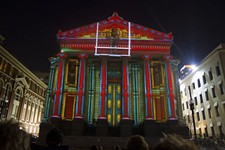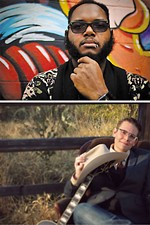We P.2ed
Art that surprises, delights, disturbs and, yes, bores.
By Andy Campbell and Kate X Messer, 10:34AM, Thu. Jan. 12, 2012
OPEN IMAGE GALLERY
Did we mention that the curtains at The Hotel Monteleone are so thick that no sunlight penetrates the room once they’re closed? That’s why we haven’t written to you in a hot minute (although we’ve been blowing up our twitter (@dandyunicorn) and our FacePlaceBookster (/dandyunicorn)).
You have been following us, right? Where else can you learn about why we’re ashamed of how our pants look under blacklights? (if you had been following us on the twitter… you'd know!)
But this is all to say that we had a full day of art and cavorting yesterday, and it is only now, after great... um... reflection that we’re serving it back to you, in the form of a piping hot pile of blog.
Yesterday we spent a significant portion of our day going around to five of the numerous P.2 venues: The Old U.S. Mint, The 1850 House (both of the Louisiana State Museum), New Orleans African-American Museum, New Orleans Museum of Art and the Newcomb Gallery at Tulane University. And the roster of artists whose work we saw was just as impressive: Jonas Dahlberg, William Eggleston, Sophie Calle, Lorraine O’Grady, Bruce Davenport, Jr., Nicole Eisenman, An-My Lê, Jennifer Steinkamp, Nick Cave and Joyce J. Scott. There’s the full account, but not everything we saw stuck with us.
Like with our trip to P.1 back in January, 2009, we began at the Mint, and like last time some of the most foreboding and distressing work was to be found in that building. During P.1 we were agog at Stephen Rhodes’ frenzied take on American electoral politics by way of Disney’s Hall of Presidents. The very same room that was once littered with hanging chads and computer innards and strewn with torn paintings and where hole-riddled particle board (functioning as low-rent screens for the host of videos seizing and sputtering) stood like so many ramparts, was now painted a dark gray and hung with large framed black and white portraits by William Eggleston entitled The Night Club Portraits (1973/2005). The tightly-framed portraits are a little over life-sized, so the characters, many burned-out, ecstatic, or drug-addled (or amazingly, all three) are an epic presence. That P.2 should begin for us with the obscure work of a well-known artist (long-championed as the harbringer of color photography as a fine art media) was provocative enough, but three rooms down was the Sony Portapak punch of Eggleston’s video Stranded in Canton (1974). This video, which makes use of vignettes volatile enough to spoil a piece of artificial fruit, stars the same people who appear in the artist’s Night Club Portraits. Shot with a 5 x 7 camera these denizens of the gothic South (New Orleans, Memphis, and other areas of the Delta Region) had nothing on the moving picture versions of themselves - doing things that make Harmony Korine and John Waters look like watered-down poseurs. We came in during a passage where one man bites the head off of a chicken. Pistols, bottles of beer, explosive words, Memphis blues all combine in a noxious stew that somehow feels … sweet. And this is what’s so distressing about Stranded in Canton. It’s effuse with new technology (Eggleston was one of the first to pick up the Sony Porta-pak) and old, terrible habits. Kate went so nuts over this film that I had to drag her out of The Mint. Our meter was expired.
What a palate cleanser, then, to be immersed in Sophie Calle’s poetic and meandering fact/fictional narrative set in the period rooms of the 1850 House (just a skip away from Café du Monde’s famous beignets). But Calle’s work, which I have always wanted to see in person, for all its personal preciousness, felt impersonal and removed. More ironic commentary on the display of the period rooms themselves (a dress on every bed, a dead cat in the living room, a TV in the slave’s quarters), Calle’s work didn’t leave me as breathless as I’d expected, but a bit bored... or rather, lost. Kate really did like the dead cat, though. Also: Sorry 1850 House, we didn’t mean to set off the alarm!
New Orleans is filled with the kind of architectural history of the 1850 House, where slave quarters are nestled under/behind the grand main house. This is not peculiar to New Orleans but is, indeed, a staple of most Southern old aristocratic buildings. One such building has now been repurposed as the New Orleans African-American Museum. The house and grounds, built and expanded by a French family by the name Meilleur (meaning: “the best”), are stunningly gorgeous. Housed in the back house (was it a slave house? We’re not sure) was Lorraine O’Grady’s forty photographs documenting her performance made for a 1983 Harlem African-American Parade in NYC entitled Art Is…. How apropos for a city that’s ready to roll down the street at any minute! A response to the quip that “the avant-garde doesn’t have anything to do with black people.” This is hogwash, of course, the avant-garde has much to do with black identities (in diaspora, and at “home” wherever that may be). O’Grady’s performance uses an economy of means to counteract such toxic rhetoric. Giving parade participants gold antiqued frames, people were able to enframe their own composition – many featuring the white policemen who were sent to keep the civil peace during the parade. But these snapshots, enframed a second time by O’Grady, are never just a flat stand-off between white and black bodies, but often are flirty and playful. Which may make some uneasy, as there were (and still are) very real and distressing dynamics between white policemen and the largely black population that inhabited Harlem in the 80s. O’Grady’s series proves, like carnivale, or Mardi Gras, that the disturbing can be situated right alongside the silly, and insodoing O’Grady makes her own indelible mark in the history of the avant-garde. Also: we loved the Colt 45 float, outfitted like a giant 40 oz piñata.
At the New Orleans Museum of Art the three artists represented Nicole Eisenman, Bruce Davenport, Jr., and Jennifer Steinkamp ably filled the large entrance/atrium with large-scale paintings, untrained drawings, and a perfectly-sited video. Most surprising to me were the paintings by Eisenman, who has long been a favorite of mine, especially for her intricate drawings turning American pop cultural icons inside-out. These paintings, really painting-collages, contain photographic representations of what an early 20th century avant-gardist might have called African fetishes, as pieces of a large painted head. The titles, Guy Artist, Guy Capitalist, Guy Racer, points to not only the male subject of the paintings, but the dudely way of handling paint; broad and sweeping with lackadaisical detail (the mouths are just a line of paint squeezed directly from the tube). Bruce Davenport’s drawings of parades from a bird’s eye view were entrancing and one could easily get lost for hours amongst the thousands of figures. The one and the many, a strong curatorial choice. Steinkamp’s video, rendered in her trademark animation that walks the line between iconic and “realistic” CGI representation, diplays the range of seasonal flora expressed through a pulsating heart of roots. Placed on the landing between the first and second floors on the grand staircase, the video itself forced viewers to become part of the animated drama, and indeed, we stood there agog, nature projecting on our backs, staring at the barely pixilated mass of leaves, fruit, and branches.
Finally, we made it to the Newcomb Gallery, where we were both excited to see Nick Cave’s soundsuits, massive body-cartons that are intricately made/detailed/woven/collaged. In the context of NOLA these soundsuits looked like Mardi Gras Indian costume castaways (one of the many resonances that work like Cave’s finds in New Orleans that it wouldn’t in New York, L.A. or Chicago), more specifically Southwest Louisianna Cajun/Creole Mardi Gras paraders – a cross between Rite of Spring and Cabaret Voltaire. But the real star of this genius pairing on the part of P.2 curator Dan Cameron, was the mini-retrspective of Joyce J. Scott’s recent work. Known for her beaded figures which augment readymade European and American figures, Scott’s work is just as powerful as Eggleston’s Porta-pak punch. Filled with phalli and sexual congress that would make Kara Walker blush, Scott’s work is a reminder of why arts that have been traditionally considered handicrafts (and thus have their own gendered, classed and raced status in the avant-garde) still are potent tools. Figures of flayed Tanzanian Albino faces, creator-goddesses, dick-decorated nkisi, and a life-size beaded figure suspended in a tree outside the gallery, her glass guts coming out of her like the roots of a tree all wrote their own intricate narratives of desire, colonialism, and the history of representation.
Well that was a pretty serious post, huh? But not to worry – we’re doing more serious art things today – like visiting the Contemporary Art Center, The Ogden Museum of Southern Art, The WWII museum and later… queerlesque!
Oh yeah. We found the queers in NOLA, and they’re lives are going to change!
As always, keep it here for more. Cos, you know, we’re Fine & Dandy with Kate & Andy.
A note to readers: Bold and uncensored, The Austin Chronicle has been Austin’s independent news source for over 40 years, expressing the community’s political and environmental concerns and supporting its active cultural scene. Now more than ever, we need your support to continue supplying Austin with independent, free press. If real news is important to you, please consider making a donation of $5, $10 or whatever you can afford, to help keep our journalism on stands.
Kate X Messer, July 27, 2012
Nov. 4, 2015
Aug. 26, 2021
New Orleans, LGBTQ, NOLA, Dan Cameron, P.2, Lorraine O'Grady, Joyce J. Scott, Nick Cave, William Eggleston, Sony Portapak












